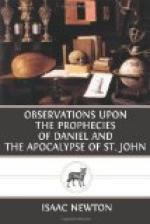After the sepulchres of Saints and Martyrs were thus converted into places of worship like the heathen temples, and the Churches into sepulchres, and a certain sort of sanctity attributed to the dead bodies of the Saints and Martyrs buried in them, and annual festivals were kept to them, with sacrifices offered to God in their name; the next step towards the invocation of Saints, was the attributing to their dead bodies, bones and other reliques, a power of working miracles, by means of the separate souls, who were supposed to know what we do or say, and to be able to do us good or hurt, and to work those miracles. This was the very notion the heathens had of the separate souls of their antient Kings and Heroes, whom they worshiped under the names of Saturn, Rhea, Jupiter, Juno, Mars, Venus, Bacchus, Ceres, Osiris, Isis, Apollo, Diana, and the rest of their Gods. For these Gods being male and female, husband and wife, son and daughter, brother and sister, are thereby discovered to be antient men and women. Now as the first step towards the invocation of Saints was set on foot by the persecution of Decius, and the second by the persecution of Dioclesian; so this third seems to have been owing to the proceedings of Constantius and Julian the Apostate. When Julian began to restore the worship of the heathen Gods, and to vilify the Saints and Martyrs; the Christians of Syria and Egypt seem to have made a great noise about the miracles done by the reliques of the Christian Saints and Martyrs, in opposition to the powers attributed by Julian and the heathens to their Idols. For Sozomen and Ruffinus tell us, that when he opened the heathen Temples, and consulted the Oracle of Apollo Daphnaeus in the suburbs of Antioch, and pressed by many sacrifices for an answer; the Oracle at length told him that the bones of the Martyr Babylas which were buried there hinder’d him from speaking. By which answer we may understand, that some Christian was got into the place where the heathen Priests used to speak thro’ a pipe in delivering their Oracles: and before this, Hilary in his book against Constantius, written in the last year of that Emperor, makes the following mention of what was then doing in the East where he was. Sine martyrio persequeris. Plus crudelitati vestrae Nero_, Deci, Maximiane, debemus. Diabolum enim per vos vicimus. Sanctus ubique beatorum martyrum sanguis exceptus est, dum in his Daemones mugiunt, dum aegritudines depelluntur, dum miraculorum opera cernuntur, elevari sine laqueis corpora, & dispensis pede faeminis vestes non defluere in faciem, uri sine ignibus spiritus, confiteri sine interrogantis incremento fidei_. And Gregory Nazianzen, in his first Oration against the Emperor Julian then reigning,




